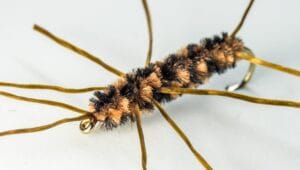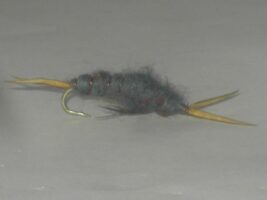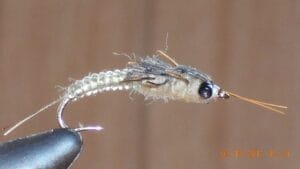Your cart is currently empty!
Pat’s Rubber Legs Stonefly Nymph Fly Pattern
Pat’s Rubber Legs stonefly nymph fly pattern represents one of the most effective and widely-used stonefly patterns in modern fly fishing. Originally developed as a simple yet highly effective imitation of large stonefly nymphs, this pattern has become a staple in fly boxes across the world. Its design emphasizes durability and lifelike movement through the…
Description
Pat’s Rubber Legs stonefly nymph fly pattern represents one of the most effective and widely-used stonefly patterns in modern fly fishing. Originally developed as a simple yet highly effective imitation of large stonefly nymphs, this pattern has become a staple in fly boxes across the world. Its design emphasizes durability and lifelike movement through the innovative use of rubber leg materials, which was revolutionary when first introduced. The pattern has evolved from its original tie to include various colors and sizes, while maintaining its essential characteristics of simplicity and effectiveness.
Premium Materials and Construction Details
Essential Materials List:
- Hook: 2X or 3X long nymph hook (sizes 4-10)
- Thread: Black or brown 6/0
- Body: Chenille or dubbing (brown, black, or olive)
- Legs: Round rubber legs
- Tail: Rubber leg material
- Optional: Lead wire for weight
- Head: Thread with clear finish
- Optional: Contrasting chenille thorax
- Optional: Wire rib
- Optional: Tungsten bead
Material Selection Considerations:
- Hook strength matches target species
- Thread strength crucial for durability
- Body material creates proper profile
- Leg material must be flexible
- Tail material matches legs
- Weight addition affects sink rate
- Head finish protects materials
- Material preparation affects profile
- Storage conditions preserve rubber
- Color selection matches conditions
Detailed Tying Instructions
Preparation Steps:
- Select appropriate hook size
- Choose quality materials
- Prepare rubber legs
- Cut chenille lengths
- Organize workspace
- Check tools
- Plan proportions
- Review pattern
- Test thread strength
- Prepare weight if needed
Step-by-Step Tying Sequence:
- Start thread behind eye
- Add weight if desired
- Tie in tail segments
- Attach rear legs
- Tie in body material
- Form tapered body
- Add middle legs
- Build thorax
- Add front legs
- Form neat head
- Whip finish
- Check proportions
Advanced Fishing Techniques
Presentation Methods:
- Dead drift nymphing
- Short-line nymphing
- Indicator nymphing
- Deep presentation
- Swing technique
- Current seam fishing
- Structure approaches
- Pattern combinations
- Multiple fly rigs
- High-stick nymphing
Water Reading Skills:
- Identify feeding lanes
- Recognize current breaks
- Spot productive runs
- Detect fish movement
- Read water clarity
- Locate prime lies
- Find transition zones
- Identify temperature breaks
- Track fish patterns
- Monitor conditions
Seasonal Strategies
Spring Tactics:
- Target pre-runoff periods
- Focus on warming water
- Match natural movement
- Adjust depth
- Monitor temperatures
- Watch for activity
- Follow fish movement
- Time presentations
- Adapt to conditions
- Match natural drift
Summer Applications:
- Early morning fishing
- Late evening sessions
- Target deep runs
- Focus on structure
- Match daily patterns
- Observe feeding windows
- Adjust to conditions
- Monitor water levels
- Watch temperatures
- Time presentations
Fall/Winter Approaches:
- Match winter stoneflies
- Target feeding fish
- Adjust presentation depth
- Watch water conditions
- Monitor temperatures
- Follow movement patterns
- Adapt to weather
- Time efforts effectively
- Match natural drift
- Adjust techniques
Technical Rigging Considerations
Leader Construction:
- Strong tippet material
- Proper diameter selection
- Breaking strength considerations
- Length adjustments
- Material choices
- Knot selection
- Sink rate control
- Visibility factors
- Setup variations
- Durability needs
Terminal Tackle:
- Direct connection methods
- Dropper setups
- Leader construction
- Line control
- Strike detection
- Depth adjustment
- Pattern spacing
- Drift control
- Presentation angles
- Setup modifications
Habitat-Specific Tactics
Water Types:
- Freestone streams
- Tailwaters
- Large rivers
- Deep runs
- Boulder pockets
- Mixed waters
- Clear streams
- Pocket water
- Riffles
- Current seams
Specific Locations:
- Feeding lanes
- Current breaks
- Structure edges
- Deep holes
- Mid-stream
- Transitions
- Drop-offs
- Shallow flats
- Travel routes
- Holding lies
Advanced Presentation Methods
Traditional Techniques:
- Dead drift
- Swing presentation
- High-stick nymphing
- Indicator fishing
- Deep presentation
- Structure approach
- Bank presentation
- Depth control
- Speed control
- Pattern selection
Modern Adaptations:
- Euro nymphing
- Indicator methods
- Multiple fly rigs
- Edge water tactics
- Structure approaches
- Pattern combinations
- Presentation modifications
- Depth control
- Speed variations
- Drift management
Pattern Variations
Size Considerations:
- Match natural stoneflies
- Consider water depth
- Adapt to pressure
- Account for clarity
- Follow seasonal trends
- Consider target species
- Match preferences
- Adapt to conditions
- Consider current
- Match forage base
Color Variations:
- Black/coffee
- Brown/tan
- Olive/black
- Golden stone
- Natural tones
- Dark variations
- Light variations
- Seasonal colors
- Water clarity match
- Regional preferences
Pat’s Rubber Legs represents the perfect fusion of simplicity and effectiveness in fly design. Its carefully selected materials and straightforward construction ensure exceptional performance across various fishing conditions. Whether targeting trout in mountain streams or searching for larger species in big rivers, this pattern provides the perfect tool for successful nymph fishing throughout the season.
Additional information
| Hook size | 10, 12, 14, 16, 18, 20, 6, 8 |
|---|---|
| Hook type | Barbed Hooks, Barbless Hooks |







